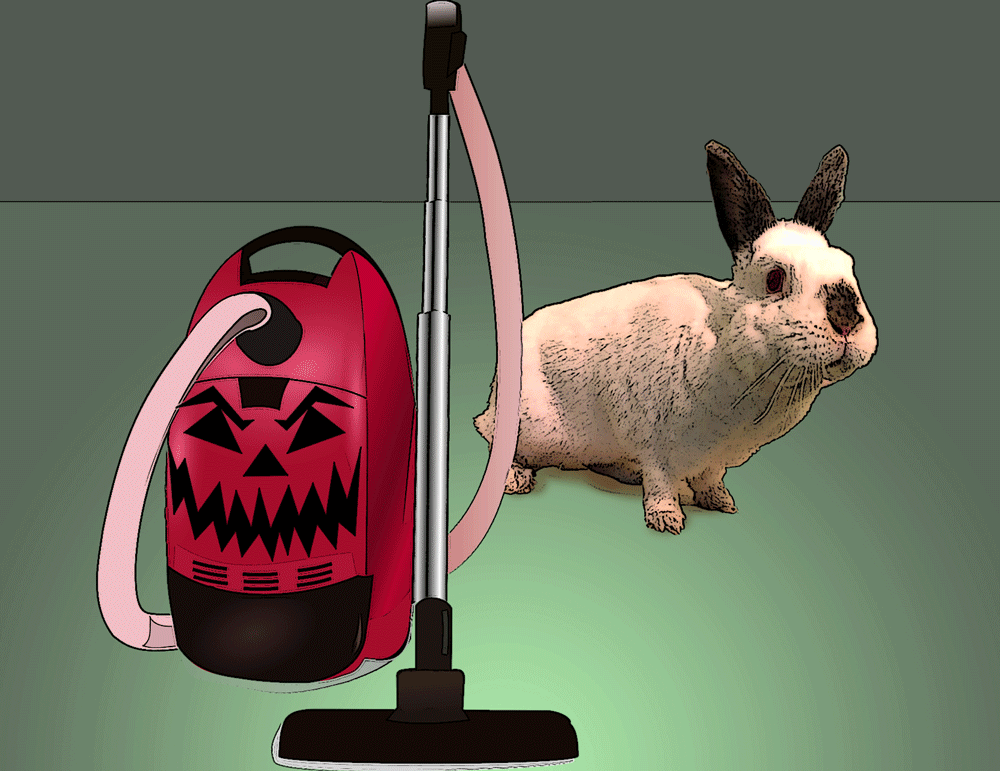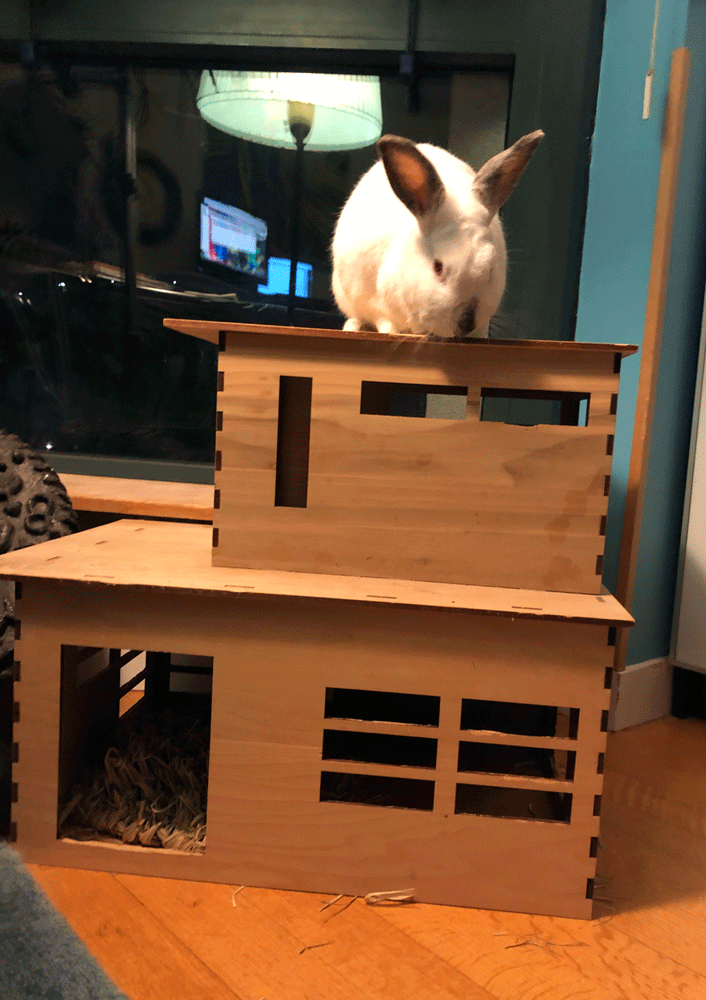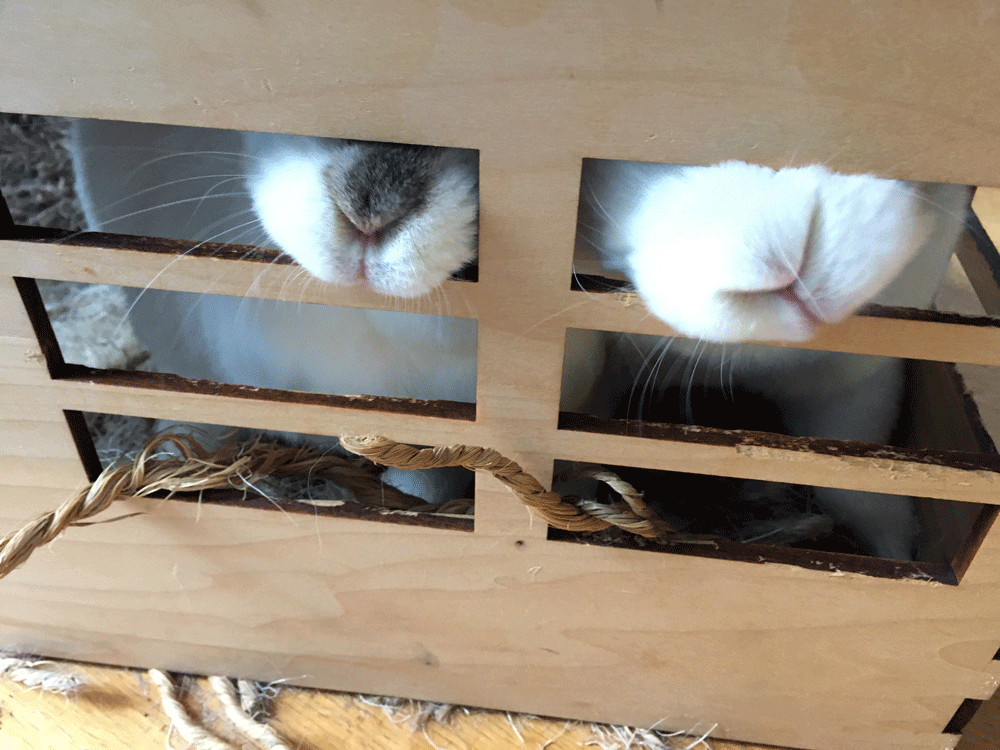
It emerges with no warning, clattering out of dark closets, the strange, shiny, hairless creature. Roaring incessantly – deafeningly – never stopping, not even to take a breath. It lurches menacingly around every room in the house, raging in and out of every nook and corner. It’s terrifying! The bane of house bunny existence: The Vacuum Cleaner.
But there is hope, fellow lagomorphs: we too used to fear this gruesome monster. But now when he appears, not only don’t we mind, we kind of enjoy it! If you’re still living in fear of Vacuumasaurus, tell your humans to read this article.
Sincerely,
Moraea and Finnegan
It’s no surprise that most rabbits are terrified of vacuums. Yet as every bunny parent knows, without regular vacuuming a layer of shed fur and hay dust can soon lay claim to every horizontal surface in the house, making your inter-species living space resemble a snow globe at rest.
If you were to ask the vacuum cleaner for its opinion, it wouldn’t be too fond of rabbits either. I doubt I am the only bunny owner whose vacuum has been completely disabled, its power cord cut by a slash of lagomorph incisors. Luckily, in my case, it wasn’t turned on at the time of the bushy-tailed ambush. I shudder to think what might have happened otherwise.
Besides the danger of burn or electric shock to your rabbit, a fearful animal can also get injured running in panic. Plus it’s difficult to do your cleaning and keep track of a frightened fuzzball at the same time. You even run the risk of accidentally stepping on or tripping over an erratically scurrying creature.
How can we get Hoovers and herbivores to co-exist peacefully?
- Protect both rabbits and vacuum from hurting each other
- Remove the fluff-tailed fear! You could even replace it with calm and fun.
The best approach depends on the configuration of your home, and, more specifically, your bunny’s territory within it.
The Multiple Rooms Solution
The most effective solution keeps Bissel and bunny in separate rooms at all times. So if you want to clean the bedroom, either wait until hop-haunch vacates it, or lure her to another room, and shut the door. At least, that accomplishes goal number one: mutual protection.
Taking the Fear Out: Desensitization and Counter Conditioning
Some rabbits might still be afraid when they hear the vacuum, even if it’s in another room. If you can’t get them out of earshot — given the size of bunny ears and the price of real estate — consider using training to make the sound less scary.
You can do this by applying what trainers call desensitization and counter conditioning (DS/CC). I wrote a separate blog post detailing this process . It’s not hard to do — you just need have patience and attend to a few details. It’s well worth it when you see how much calmer and happier your rabbit is when you’re done.

The Single Room Solution
But what if, like me, your rabbit only lives in one room?
Step One: Gimme Shelter
Make sure there are places to hide. Ideally there should be many such nooks in your bunny’s space for her to choose from. What you’re going to do is teach her to get in one and stay in there until you finish vacuuming. That will not only make her comfortable with the experience, it will also keep her and the machine away from each other, so no one gets hurt!
Which safe spot does your puff-pawed panicker choose to hide in most often when she’s uncomfortable? If you don’t already know the answer to that, spend some time observing her habits before you begin the training. If you don’t see a strong preference, choose the one that works best to keep her out of the way when you vacuum.
Step Two: Desensitization and Counter Conditioning (DS/CC) in the Safe Haven
Once you’ve figured out which hiding place to use, get a partner to work with you. One of you will be managing the vacuum while the other will be the treat feeder. You’ll want two people because you have to keep the vacuum at a distance your bun is comfortable with. In order for desensitization and counter-conditioning training to work you must minimize delay between when she notices the vacuum and when she gets a treat. You can’t be walking back and forth.
With bunny safe spot chosen and helper in place, here’s what to do, step by step:
- Wait until your rabbit is in her safe spot.
- The vacuum handler should do whatever makes your bun first show signs of vacuum awareness, whether that’s getting the vacuum out of the closet, plugging it in, or turning it on.
- As described in the DS/CC blog, immediately after the threat is perceived at the lowest level, the treat giver should start feeding.
- Remove the threat. (Turn off the vacuum or put it away.) Treats should cease.
Confident bunnies will quickly start to enjoy this. As always, you will have to go at your own bun’s unique pace. Eventually your rabbit should begin to associate the vacuum with the safe haven and coming treats. She’ll start to go there as soon as you get it out or turn it on.
Step 3: Learning to Stay Put

Once whisker-face gets used to the idea of eating treats in her hideout while the vacuum is running, you’ll want to increase the time between treats. The goal here is to get enough duration between treats so you don’t need two people every time you vacuum. So start counting: <treat> “one” <treat>. Then the next time, <treat> one, two <treat>, and so on. If she starts to get nervous, back up a beat or two and start again.
Eventually you’ll have enough time between treats so one person can give treats, vacuum at a distance, run back and give more treats, and so on. Also, vacuuming the entire room may take longer than the number of treats it’s safe to give your bun in a single day. You’ll work up to being able to vacuum the whole room in one go gradually as her tolerance for duration increases.
Don’t go near her hiding place when you vacuum yet. During this stage of the training, keep far enough away that she doesn’t tense up or look like she might bolt. Clean that area separately, using mop, broom or other tools that won’t scare her, at a time when she’s not occupying it.
Once you’ve attained sufficient duration, you’ll start to work on getting the vacuum closer to the hideout. Same guidelines:
- go gradually
- make sure you feed enough treats to keep her happy
- back off if she’s starting to look stressed
You’ll likely always need to hand-clean the area immediately around where her safe-haven is located. Even Moraea, my fearless Warrior Princess, will abandon ship if the evil vacuum creeps too close to her hideaway!
Vacuumorphosis: The Finished Product
The video below is what vacuum time looks like at our house these days. Because Moraea and Finnegan have had plenty of training on this, we no longer wait for them to be in their house before we start. The sight or sound of the vacuum has become a cue for them to go to the house. With that in mind, I “pre-load” the empty house with treats, and immediately start the vacuum. The sound of the vacuum triggers them to run to the house; once there they find a pre-loaded treat buffet, with refills coming soon.
However if one or both the buns already happened to be lounging in the house before I got out the vacuum, I would start differently. In that case I would start the motor first and then immediately go over to the house and put in the treats. Remember, the vacuum always has to come before the treat!
Smoothing the Path to Hoover Heaven
One final word of caution: If your furry-footed friend experiences another scare related to the vacuum before you’re done, it will set back all the progress you’ve made. So, once you start this training process:
- Don’t vacuum unless you are using this method.
- Stop hoovering if your bun ever gets so upset that she will no longer take a treat.
(Note: there’s a difference between not taking a treat because she’s upset and just being so full she can’t eat another! In the former, you’ll see signs of stress; in the latter, she’ll probably just lie down for a nap.)
Obviously this will limit your cleaning choices for a while. I’ve gotten really good at vacuum alternatives, like using a broom and dustpan to sweep up hay and poop, or a squeegee to scrape up hair from carpet and fabric. This is temporary, so be patient. Practicing often at a level that your rabbit is comfortable with will speed up the process. You’re done when you can vacuum the room without ruffling any bunny fur.
BONUS TIP: I found that teaching this routine to Moraea made it ten times easier for Finnegan to catch on when we adopted him. That’s because rabbits tend to seek the shelter of their herd when threatened. So, once mastered, it’s a skill that can be passed down from rabbit to rabbit!
 The Fluffy Tail of This Blog Post
The Fluffy Tail of This Blog Post
For me and my fuzz-faced friends, vacuum training has been a great enhancement. Although I don’t relish vacuum time, they actually do. The fun of seeing their little noses poking through their hidey house windows, eagerly jockeying for treats, is a silver lining on the drudgery cloud of cleaning.
syl says:
I love the art work!!
Wish my vacuum was as threatening! Carpets might be cleaner!